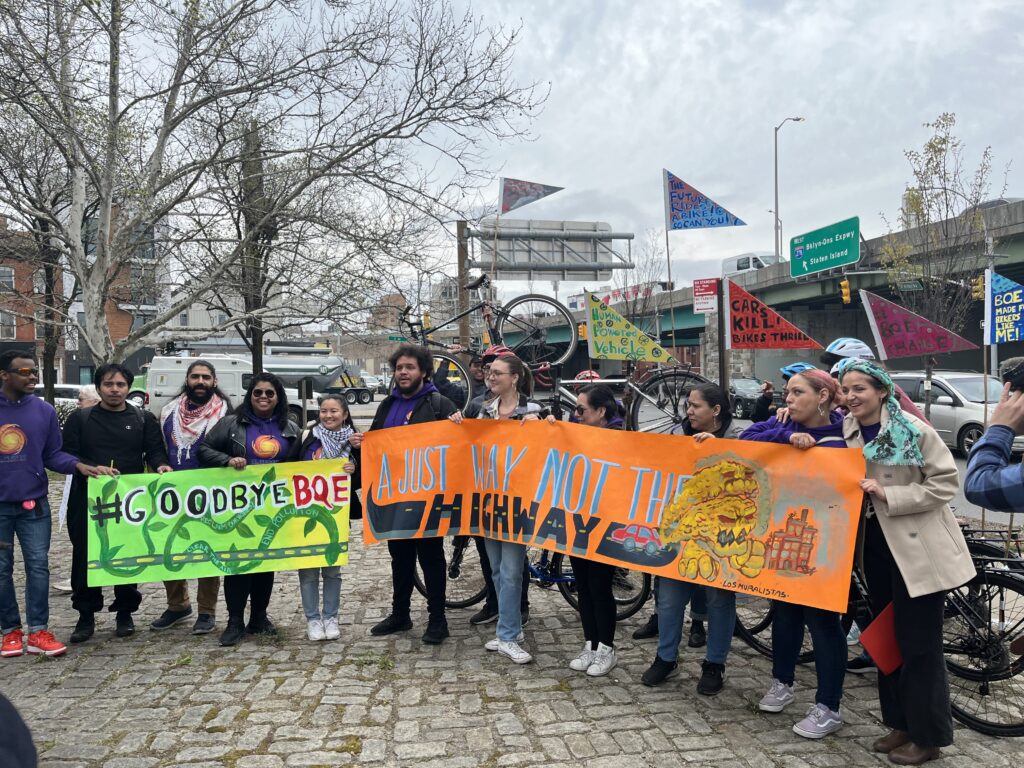In Brooklyn, El Puente stands as a beacon of hope and resilience for the residents of the bustling, yet polluted, Williamsburg neighborhood. We sat down with El Puente’s Deputy Director of Programs, Asenhat Gomez, to explore the complex web of environmental issues confronting this dynamic community and uncovered the profound influence of the organization’s unwavering dedication to grassroots activism and youth empowerment.
How does Environmental Justice impact El Puente’s community?
We are based in Williamsburg, which is a waterfront community that has so much transportation infrastructure impacting it, making it one of the communities with the highest asthma rates in the city. We have the Brooklyn-Queens Expressway (BQE) going through the community; we have the Williamsburg Bridge; we have a bus depot and we have an immense amount of truck traffic. All of those reasons make our community vulnerable to climate and environmental hazards.
Tell us about your Environmental Justice programs. How did El Puente first get involved with this work?
El Puente was born as a human rights and youth-centered organization. It was our young people back in the late ‘80s that made El Puente aware of the environmental problems. They really took on our first environmental justice campaign after they discovered a radioactive site. We always look to the leadership of our young people, so El Puente engaged in this campaign that lasted two decades to minimize radioactivity here.
Then, there was a 55-story incinerator that was going to be built in our community. El Puente convened a coalition of community residents that included Latinos, African-Americans and also our Hasidic neighbors. That coalition led a campaign to stop that incinerator from coming to fruition, and it was successful.
In that same vein, we have fought for years for the quality of the open spaces and parks in this neighborhood. We are underserved in park space relative to the number of people who live here. The park spaces are all aligned under the BQE, making the air quality really poor. It will not improve until the infrastructure changes.

Could you expand on the projects you’re currently working on?
Recently, we kicked off our Environmental Justice (EJ) coalition working on the BQE campaign. Young people rode in on their bikes, made creative flags and a lot of art to bring attention to what is happening here. We’ve been working closely with our elected officials — certainly our city and state representatives, but also our federal elected officials — to make sure there’s a push at all levels to do what’s right.
El Puente has also been working on a project that we co-lead called “BQ Green.” This project is decorating the BQE in parts where there are parks that are separated by it. Decorating these segments of the expressway will allow for an added piece of land that the community can design, that can perhaps become a community trust. We also exist in Puerto Rico, where our work is almost exclusively climate and environmental justice.
How has your involvement with YOCCF supported your Environmental Justice campaigns?
YOCCF has been such a match for El Puente because of the intersectionality of young people, the arts, organizing and mobilizing. Shareef Dean, who also serves on YOCCF’s Youth Advisory Group, is a muralist for our campaigns. Our “muralistas” have been working on a mural that speaks to the BQE campaign.
Everything we do is reflected in the arts and our young people. We believe in people who use the arts to activate, and I think that’s always a highlight. Young people are so creative; they’ve come up with their own vision of how they see the BQE and this campaign.
What activities does El Puente have planned for Earth Day?
We plan to do one of our Environmental Justice tours and activations during Earth Week. It’s a way of informing people about the issues by allowing them to experience what we are talking about. We are also doing some things as it relates to children of the world who are impacted by environmental justice, so we’re doing a lot of arts activations with our young people.
Do you have any parting words on Environmental Justice that you want to share?
Our view on environmental justice is that it isn’t separate from other injustices that communities experience. These things don’t exist in a bubble; they’re all connected because they’re part of our daily lives. If we don’t take care of the things that we all need to live, what’s going to happen? I think that’s the question the young people are asking us: What are you all leaving behind for us to be able to sustain life?
We do this work not for the community but with the community, always. We are part of the community. So many of our young people live here, they’ve grown up here; so much of our staff lives here. I always say to young people, change takes a very long time. I was a child here; I was a member of El Puente when the incinerator fight was happening. I was a kid who marched the Williamsburg Bridge to protest this incinerator and here we are still fighting for some of the same things. Patience, commitment and perseverance are needed to build strong coalitions that last.